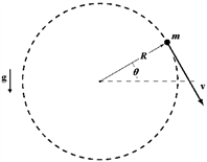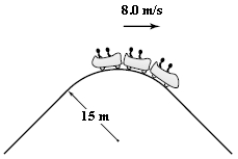A) 15 m/s
B) 49 m/s
C) 30 m/s
D) 42 m/s
E) 36 m/s
G) A) and C)
Correct Answer

verified
Correct Answer
verified
Multiple Choice
An iceboat is traveling in a circle on the ice. Halfway around the circle the sail and the steering mechanism fall off the boat. Which statement is correct?
A) The boat will continue traveling in the circle because there is no friction.
B) The boat will continue to travel in the circle because its velocity exerts a force on it.
C) The boat will move off on a line tangent to the circle because there is no force on it.
D) The boat will move off tangent to the circle because there is a force on it perpendicular to the boat directed to the outside of the circle.
E) The boat will move off to the outside perpendicular to the tangent line since a force directed to the outside of the circle always acts on the boat.
G) C) and D)
Correct Answer

verified
Correct Answer
verified
Multiple Choice
A 1.8-kg block is projected up a rough 10° inclined plane. As the block slides up the incline, its acceleration is 3.8 m/s2 down the incline. What is the magnitude of the force of friction acting on the block?
A) 5.0 N
B) 3.8 N
C) 4.2 N
D) 4.6 N
E) 6.5 N
G) A) and C)
Correct Answer

verified
Correct Answer
verified
Multiple Choice
An object attached to the end of a string swings in a vertical circle (R = 1.2 m) , as shown. At an instant when θ = 30°, the speed of the object is 5.1 m/s and the tension in the string has a magnitude of 20 N. What is the mass of the object? 
A) 2.0 kg
B) 1.5 kg
C) 1.8 kg
D) 1.2 kg
E) 0.80 kg
G) None of the above
Correct Answer

verified
Correct Answer
verified
Multiple Choice
A 2.0-kg block slides on a rough horizontal surface. A force (P = 6.0 N) is applied to the block as shown. The magnitude of the block's acceleration is 1.2 m/s2. What is the magnitude of the force of friction acting on the block? 
A) 2.0 N
B) 1.4 N
C) 1.6 N
D) 2.8 N
E) 3.4 N
G) A) and E)
Correct Answer

verified
Correct Answer
verified
Multiple Choice
The equation below is the solution to a problem.  .
The best physical representation of this equation is
.
The best physical representation of this equation is
A) a sphere of 2.00-kg mass under a 6.00-N tension when at the bottom of a vertical circle.
B) a sphere of 2.00-kg mass under a 6.00-N tension when at the side of a vertical circle.
C) a sphere of 2.00-kg mass under a 6.00-N tension when at the top of a vertical circle.
D) a sphere of 2.00-kg mass at any point on a horizontal circle.
E) a 2.00-kg gecko running on the ceiling with a speed of 8.00 m/s.
G) A) and B)
Correct Answer

verified
Correct Answer
verified
Multiple Choice
A stunt pilot weighing 0.70 kN performs a vertical circular dive of radius 0.80 km. At the bottom of the dive, the pilot has a speed of 0.20 km/s which at that instant is not changing. What force does the plane exert on the pilot?
A) 3.6 kN up
B) 4.3 kN up
C) 2.9 kN down
D) 2.9 kN up
E) 5.8 kN down
G) A) and D)
Correct Answer

verified
Correct Answer
verified
Multiple Choice
If a 20-kg object dropped in air has a terminal speed of 60 m/s, what was its acceleration at 30 m/s?
A) 9.80 m/s2
B) 7.35 m/s2
C) 4.90 m/s2
D) 2.45 m/s2
E) More information is needed to answer this question.
G) A) and C)
Correct Answer

verified
Correct Answer
verified
Multiple Choice
A rock attached to a string swings in a vertical circle. Which free-body diagram could correctly describe the force(s) on the rock when the string is in one possible horizontal position, where  is the normal force,
is the normal force,  is weight, and
is weight, and  is tension?
is tension?
A) ![]()
B) ![]()
C) ![]()
D) ![]()
E) ![]()
G) C) and E)
Correct Answer

verified
Correct Answer
verified
Multiple Choice
A 0.50-kg mass attached to the end of a string swings in a vertical circle (radius = 2.0 m) . When the string is horizontal, the speed of the mass is 8.0 m/s. What is the magnitude of the force of the string on the mass at this position?
A) 16 N
B) 17 N
C) 21 N
D) 11 N
E) 25 N
G) A) and D)
Correct Answer

verified
Correct Answer
verified
Multiple Choice
A boy on board a cruise ship drops a 30.0 g marble into the ocean. If the resistive force proportionality constant is 0.500 kg/s, what is the terminal speed of the marble in m/s?
A) 0.147
B) 0.294
C) 0.588
D) 1.18
E) 2.35
G) B) and E)
Correct Answer

verified
Correct Answer
verified
Multiple Choice
A highway curve has a radius of 0.14 km and is unbanked. A car weighing 12 kN goes around the curve at a speed of 24 m/s without slipping. What is the magnitude of the horizontal force of the road on the car?
A) 12 kN
B) 17 kN
C) 13 kN
D) 5.0 kN
E) 49 kN
G) None of the above
Correct Answer

verified
Correct Answer
verified
Short Answer
A small dense object is suspended from the rear view mirror in a car by a lightweight fiber. As the car is accelerating at 1.90 m/s2, what angle does the string make with the vertical?
Correct Answer

verified
Correct Answer
verified
Multiple Choice
A 50-kg child riding a Ferris wheel (radius = 10 m) travels in a vertical circle. The wheel completes one revolution every 10 s. What is the magnitude of the force on the child by the seat at the highest point on the circular path?
A) 0.29 kN
B) 0.49 kN
C) 0.69 kN
D) 0.20 kN
E) 0.40 kN
G) B) and E)
Correct Answer

verified
Correct Answer
verified
Multiple Choice
A roller-coaster car has a mass of 500 kg when fully loaded with passengers. The car passes over a hill of radius 15 m, as shown. At the top of the hill, the car has a speed of 8.0 m/s. What is the force of the track on the car at the top of the hill? 
A) 7.0 kN up
B) 7.0 kN down
C) 2.8 kN down
D) 2.8 kN up
E) 5.6 kN down
G) A) and D)
Correct Answer

verified
Correct Answer
verified
Multiple Choice
A 0.50-kg mass attached to the end of a string swings in a vertical circle (radius = 2.0 m) . When the mass is at the highest point of the circle the speed of the mass is 8.0 m/s. What is the magnitude of the force of the string on the mass at this position?
A) 21 N
B) 11 N
C) 16 N
D) 26 N
E) 36 N
G) A) and D)
Correct Answer

verified
Correct Answer
verified
Multiple Choice
A 4.0-kg mass on the end of a string rotates in a circular motion on a horizontal frictionless table. The mass has a constant speed of 2.0 m/s and the radius of the circle is 0.80 m. What is the magnitude of the resultant force acting on the mass?
A) 39 N
B) 20 N
C) 44 N
D) 0 N
E) 30 N
G) B) and E)
Correct Answer

verified
Correct Answer
verified
Multiple Choice
Frank says that if you release the string when swinging a ball in a horizontal circle, the ball flies out in the radial direction defined by the string at the instant you release the ball. John says that it flies out along a tangent line perpendicular to the string, and that it then drops straight down to the ground. Which one, if either, is correct?
A) Frank, because the centrifugal force is no longer counteracted by the string.
B) Frank, because balls naturally fly straight out.
C) John, because there is no centrifugal force.
D) John, because balls fall straight down when released.
E) Neither, because although there is no centrifugal force, and the ball's velocity is tangent to the circle at the instant of release, the ball then follows a parabolic trajectory.
G) A) and B)
Correct Answer

verified
Correct Answer
verified
Multiple Choice
A car enters a level, unbanked semi-circular hairpin turn of 300 m radius at a speed of 40 m/s. The coefficient of friction between the tires and the road is μ = 0.25. If the car maintains a constant speed of 40 m/s, it will
A) attempt to dig into the road surface.
B) tend to veer toward the center of the semicircle.
C) arrive safely at the end of the semicircle.
D) tend to veer toward the outside of the circle.
E) veer toward the center for the first quarter-circle, then veer toward the outside for the second quarter-circle.
G) None of the above
Correct Answer

verified
Correct Answer
verified
Multiple Choice
A car travels around an unbanked highway curve (radius 0.15 km) at a constant speed of 25 m/s. What is the magnitude of the resultant force acting on the driver, who weighs 0.80 kN?
A) 0.87 kN
B) 0.34 kN
C) 0.80 kN
D) 0.00 kN
E) 0.67 kN
G) B) and C)
Correct Answer

verified
Correct Answer
verified
Showing 21 - 40 of 64
Related Exams